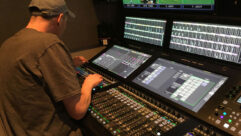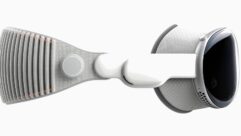
SAFETY HARBOR, FLORIDA – FEBRUARY 2016: “I’ve been an audio engineer and musician for close to forty years now, and I’ve spent most of that time passionately pursuing audiophile-quality capture and reproduction of live musical events,” said John Servies, one of the team of audio engineers behind NPR’s From the Top, which brings the stories of young musicians to 700,000 loyal listeners every week. “I enjoy systems that can impart the full intent of the artist, and I’m interested in the science of how that happens. I want to achieve a translatable effect from what the artist produces to what the audience hears; but there’s so much that can get in the way of that.” When he’s not taping for From the Top, Servies works FOH for Itzhak Perlman’s In the Fiddler’s House, Hankus Netsky & The Klezmer Conservatory Band, and a long list of one-off engagements. In short, Servies is blessed with the opportunity to travel the world, working with brilliant artists to help them fully realize the emotional impact of their craft through faithful sound reinforcement and capture.

What stands in the way of faithful sound reinforcement and capture? “The list is almost infinite,” said Servies. “But some of the biggest issues involve the acoustic environment, which includes the ways reflections, diffusion, and room modes and resonances interact. Nonlinearities in microphones, consoles, amplifiers, and especially loudspeakers can really upset the purity of sound reinforcement. And then you have to combine those two universes of potential distortion with loudspeaker placement. I routinely walk into new venues, and I only have a short amount of time to assess the acoustics and electronics and make corrections before the show or taping begins.” To speed that process and to improve its accuracy and repeatability, Servies has been using Metric Halo’s SpectraFoo sound analysis software since 2002.
“SpectraFoo allows me to quickly and accurately evaluate what my ears and brain are analyzing, and I have a refined work flow after using it for so many years,” he said. “I usually start by talking into a common reference mic that I bring to every engagement. By listening to the way the system and room react to my voice in conjunction with SpectraFoo’s spectragraph, it’s easy to identify the biggest room modes and electro-acoustical system resonances. Then I move into the more technical analysis using pink noise, playback of various test tones and music, and multi-mic/multi-placement analysis, again in conjunction with SpectraFoo’s spectragraph. Ultimately, I integrate all of those tests as one big holistic process.”
“When I made the move to sound analysis software in 2002, the only other big-name option was PC-based, and I’m a confirmed Mac user,” Servies said. “That said, SpectraFoo blew the other options out the window, irrespective of platform. I love its look, its ease-of-use, and its consistency. It doesn’t have a lot of screen clutter, and I’m able to customize and quickly switch between the types of analysis that I want to see. Moreover, SpectraFoo is really fast! I have it on my up-to-date MacBook Pro, where it obviously runs without a hiccup, but I also have it on my old PowerBook G4, where it also runs without a glitch.”
Servies has used all of SpectraFoo’s functions, which include spectragrams, oscilloscopes, level meters, Lissajous plots, and more (including Metric Halo’s unique ‘phase torch’), at one time or another. His approach blends the kind of experienced analysis he can do using just his ears and brain with SpectraFoo’s consistent and grounded analysis, which together yield excellent results in a minimum amount of time. “I’m perfectly happy to use SpectraFoo’s delay finder,” he said as an example. “But it’s faster for me to just play a 5ms pink noise ‘click’ – created with SpectraFoo – and walk around the room with my tablet, adjusting the delay times by ear.” After that, he readjusts the gain in all zones as needed and replays the pink noise, repeating various parts of the process until a favorable result is achieved. He keeps SpectraFoo open during performances as well, to help quickly diagnose and fix large or small imperfections by sending the suspect channel for analysis.
In all, Servies gets excellent, repeatable results by incorporating SpectraFoo into his workflow. In the end, he gets to enjoy a great performance with sound reinforcement that is as faithful to the instruments on stage as possible. “I won’t do a show without it!”
ABOUT METRIC HALO
Based on the Gulf Coast of Florida, Metric Halo provides the world with award-winning software and hardware recording, processing, metering and analysis solutions.










